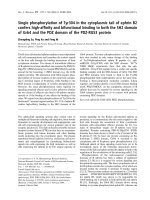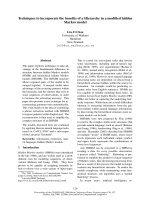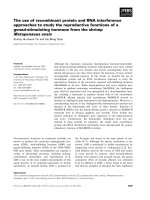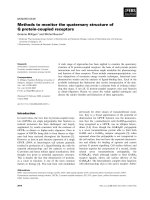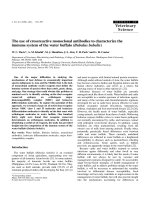To cheat or not to cheat the strategic decision of electoral fraud in competitive autocracies
Bạn đang xem bản rút gọn của tài liệu. Xem và tải ngay bản đầy đủ của tài liệu tại đây (933.32 KB, 70 trang )
Waqar |1
TO CHEAT OF NOT TO CHEAT: THE
STRATEGIC DECISION OF ELECTORAL
FRAUD IN COMPETITIVE AUTOCRACIES.
MARIA WAQAR
Masters (Soc.Sci), NUS
FOR THE DEGREE OF MASTER OF
POLITICAL SCIENCE
DEPARTMENT OF POLITICAL SCIENCE
NATIONAL UNIVERSITY OF SINGAPORE
2011
Waqar |2
Acknowledgements
I joined the Political Science Department at NUS as an overzealous student with no specific
research agenda. Half way through the gruelling seminars on research methodology and
comparative politics, my enthusiasm was partially replaced by a longing to find my place in
the discipline. I questioned my ideas, my intelligence and even my interest in the discipline
on several occasions during my academic journey. Thankfully, researching on this thesis has
served as an epiphany; it has made me discover my true academic inclinations and research
interests. The rigorous process of research and writing has definitely polished my intellect
and has been the most rewarding academic experience of my life.
This thesis could never have been possible without the patience and valuable feedback of Dr.
Terence Lee. His incisive interrogation of my ideas challenged me to produce a better piece
of work. He introduced me to recent literature on autocratic regimes and thus I credit him
for my fascination with authoritarianism. I would also like to thank Zha Wen, my dearest
comrade and fellow student, with whom I spent most of my lonely days in Singapore. Her
work ethic, intellect and wit truly inspired me while I toiled on this project.
I would also like to acknowledge two other academics for influencing my intellectual
pursuits at NUS. I would like to thank Dr. Jamie Seth Davidson for teaching the graduate
seminar on comparative politics with such perspicacity. I am also grateful to Dr. Terry Nardin
for encouraging me to always get the logic of my theory right. Lastly, I would like to extend
my gratitude to my dear husband, Laraib Mahar, for his love and words of encouragement
which made me finish this project on time.
Waqar |3
Contents
Introduction.................................................................................................1
Alternative Explanations.........................................................................11
Theoretical Framework...........................................................................18
Case-studies.................................................................................................33
Conclusion....................................................................................................54
Bibliography................................................................................................61
Waqar |4
Figures
Fig. 1...................................................................................................12
Fig. 2....................................................................................................15
Fig. 3....................................................................................................23
Fig. 4a..................................................................................................26
Fig. 4b..................................................................................................31
Fig. 5....................................................................................................32
Waqar |5
Abstract
Why does pressure to hold free and fair elections by the opposition prevent some
competitive autocrats from stealing elections but not others? My paper illustrates how
extent of power-sharing in the autocratic party determines the decision to either refrain
from ballot-rigging or try to cling to power through electoral fraud when the opposition can
credibly threaten a massive civil disobedience against tainted elections. I argue that diffused
power in the ruling party/high power-sharing amongst party elites makes the autocrat
refrain from electoral rigging, even at the risk of losing, when there is a high threat that the
opposition will lead a large-scale civil disobedience to challenge tainted election results.
While in the case of concentrated power in the ruling party/low power-sharing amongst
party elites the autocrat will rig elections to cling to power even when there is a high threat
of civil disobedience following suit. I analyze the contrasting cases of the Socialist Party of
Serbia and Institutional Republican Party in Mexico to test my theory.
Waqar |6
Introduction
During the Third Wave of Democratization, electoral autocrats responded in different ways
to domestic pressure for free and fair elections. In 1994 the revolutionary Zapatista army,
which had initiated a leftist armed rebellion in many parts of Mexico, demanded free and
fair elections from the authoritarian government. This challenge emboldened
institutionalized civil society and led to Mexico’s opposition parties jointly signing a pact for
pushing electoral reforms. President Ernesto Zedillo of the dominant Institutional Republic
Party (PRI), conceded by creating an independent Federal Electoral Institute (IFE) before
presidential elections of 1994. The IFE had previously been under government’s control and
thus had often been accused of manipulating of votes to guarantee the PRI’s electoral
victory by opposition groups. This breakthrough in electoral reform was to symbolize the
government’s willingness to hold clean elections by detaching itself from control of the
electoral process.
Conversely, the demand for free and fair elections made by the united opposition in Serbia
was not heeded by President Milosevic’s Socialist Party of Serbia (SPS). The call for clean
elections was vociferously put forward at a large protest rally attended by nearly 200,000
citizens in the capital city of Belgrade five months before the 2000 presidential elections.1
However, the government still engaged in widespread electoral which instigated opposition
parties and thousands of their supporters to come out on the streets to challenge election
results. Subsequently this triggered the defection of the armed forces from the
1
See Goati 2000, 45-59
Waqar |7
authoritarian government and fresh elections which brought the opposition candidate
Vojislav Koštunica to power.
Why does pressure to hold free and fair elections by the opposition prevent some
competitive autocrats from stealing elections2 but not others?
Unlike democratic elections, those held in authoritarian regimes are typically neither free
nor fair. Schedler highlights the “menu of manipulation” that autocrats avail to control
elections. Dictators determine rules of the electoral game through restrictions on civil and
political liberties and electoral laws which give incumbents an unfair advantage in the
electoral arena. And through vote-buying, intimidation of political opponents and voters
and manipulation of the vote-count, autocrats control the game of elections itself. 3
Since autocrats control elections in myriad ways to ensure that they emerge victorious at
the polls, opposition parties are meant to lose elections.4 However, elections in competitive
authoritarian regimes are not clear games of contestation which always yield predictable
results. While autocrats control the rules of the electoral game, the opposition parties
control the legitimacy of elections.5 Unlike hegemonic authoritarian regimes, where
opposition only exists at the margins of the political system and elections are simply a
procedural activity (like in Singapore, Uzbekistan) the opposition in competitive autocracies
(for instance, Mexico during the 1990s, Egypt since the 1990s) has the capacity to defeat the
2
Stealing refers to electoral fraud or annulment of election by the incumbent regime to maintain its control.
Schedler 2002a, 36-50 and 2002b, 105-108; Birch 2009, 395-410; Case 2009, 95-112
4
See section on opposition parties in Schedler 2009, 381-394
5
See Schedler 2002b, 113. Schedler conceives of democratization through elections should as a nested game –
at the meta-game level autocrats controls the electoral rules, while major choices for opposition actors are at
the game level of electoral competition.
3
Waqar |8
authoritarian incumbents. This makes electoral cheating even more necessary for autocrats
to ensure their victory.6
Yet paradoxically so, electoral rigging can potentially be a risky decision when a relatively
strong opposition can threaten to challenge election results. For example, Fabrice Lehoucq
and Ivan Molina in their detailed study on electoral fraud in Costa Rica find out that as interparty competition rose, paradoxically parties faced more incentives to “denounce and
commit fraud”.7 Similarly Dominguez and McCann in their study of electoral fraud under the
PRI in Mexico argue that accusations against fraud were more common in the more
competitive urban areas.8 Thompson and Kuntz argue that stolen elections can be a focal
point for channelling public dissent because it creates an “imagined community” of robbed
voters.9 And Joshua Tucker argues that even though ordinary citizens might not challenge
the regime due to collective action problems in everyday life, electoral fraud radically alters
the individual’s calculus about partaking in protests to dislodge an unpopular regime.10
This thesis explains why certain competitive autocrats take the risky decision of electoral
rigging while others do not, when faced with similar pressure from the opposition to hold
free and fair elections. Due to the remarkable durability of electoral autocracies, there has
been considerable scholarly interest in studying the role of electoral fraud in the preserving
the dominance of autocratic parties.11
6
See Levitsky and Way, 2000 on differences between authoritarian regimes which hold elections.
Lehoucq and Molina cited in Schedler 2002b, 116.
8
Domınguez and McCann 1996, 269
9
Thompson and Kuntz 2004, 162
10
Tucker 2007, 540-542
11
See Schedler and Birch, 2009; Also see Magaloni 2006, Ch. 8 and 2010, 751–765
7
Waqar |9
My argument illustrates how diffusion/concentration of decision-making power (or high/low
power-sharing) in the ruling party affects the autocrat’s choice to either refrain from ballotrigging or steal elections when there is a threat that tainted elections will cause mass
protests. Variation in power-sharing is the independent variable explaining why the threat
of mass revolt by the opposition will make some autocrats refrain from ballot rigging but not
others.
Autocratic parties with diffused power or high power-sharing amongst elites are more likely
to respond to the credible threat of post-election challenges by abstaining from electoral
fraud. For party elites losing elections peacefully without electoral manipulation actually has
a higher payoff than that for inciting mass protests through ballot-rigging which can
instigate the defection of the armed forces and in turn fresh elections. In this scenario, the
party stands to lose legitimacy which can cause the defection of its voters and party
members thereby threatening its disintegration and demise of political careers of party
members. Whereas losing elections still allows the party to have some access to state
resources and control over policy-making due to some legislative representation. Thus by
avoiding tampering with votes, such a ruling party will serve the collective interest of party
elites i.e. maintaining party legitimacy and cohesiveness.
On the contrary, parties with concentration of power or low power-sharing amongst elites
are less likely to be receptive to the likelihood of a mass challenge by the opposition in the
aftermath of electoral cheating. Due to the centralized nature of decision-making in the
party, the dictator cannot be stopped from rigging elections in spite of a high probability of
mass conflict. This is because for the dictator and his loyalists the payoffs for losing “clean”
elections are the same as that for inciting mass conflict through electoral fraud which leads
W a q a r | 10
to the defection of the armed forces and fresh elections. Both result in the worst-case
scenario of the loss of the highest political office and legal impunity for the top leader.
Therefore the party with low power-sharing is more likely to take the risk of rigging
elections so that the top leader can cling to power, even if there is formidable pressure from
the opposition to hold free and fair elections.
My study endeavours to be an important addition to the burgeoning literature on electoral
authoritarianism and democratization. Regular elections have played an important role in
durability of authoritarian regimes because they are an important institutional mechanism
through which members of society can become part of or sustain membership in the ruling
authoritarian coalition and thus have access to perks, rents and other state resources.12
However elections in competitive autocracies are not an easy win for incumbents; they are
rather strategic affairs during which incumbents’ decisions have to carefully anticipate the
opposition’s response to techniques of electoral manipulation. A fascinating string of
“coloured revolutions” in Serbia (2000), Ukraine (2002), Georgia (2003) and Kyrgyzstan
(2004) in the new millennium has shown how ordinary citizens have the capacity to
challenge and bring down authoritarian governments which blatantly manipulated elections.
Yet at the same time other electoral autocrats in Mexico (1994), Senegal (2000) and Kenya
(2002) behaved in a more prudent manner when faced with a strong opposition demanding
free and fair elections.
There is no convincing theoretical explanation of why some competitive autocrats risked
mass conflict in their drive to cling to power through extensive ballot-rigging while others
12
See Lisa Blaydes, 2006 and Beatriz Magaloni 2008, 195-218 for an analysis on politics of rent distribution in
authoritarian regimes
W a q a r | 11
preferred losing clean elections. This paper will explain what conditions will make certain
electoral autocrats give up power to opposition forces to allow “liberalizing electoral
outcomes”13 or an “electoral alternations”14 but not others.
Methodology and case selection
My method consists of analyzing small-n case studies of elections under competitive
autocracies. My case selection seeks variation on my independent and dependent variables.
Since I am aiming to explain why autocratic elites faced with the same social conditions
behave in different ways, I use the “congruence method” of case study. In the congruence
method, a theory providing deductive hypotheses or empirical generalizations for how
variation in the independent variable leads to the variation of the dependent variable is
empirically tested without the need to trace the exact process.15 This method is suitable for
my research because dynamics of elite decision-making – like motivations of leaders, intraelite bargaining - is often veiled from public scrutiny and the exact causal process linking the
independent to the dependent variable cannot be unambiguously traced. Therefore using a
decision-making tree in my theoretical framework, I show why rational leaders strategically
choose from alternative courses of action and make some predictive deductions. I use my
cases to then test these deductions which explain the variation in rational behaviour of
elites constrained by similar environment.
As I have explained above my theory is only applicable to competitive autocracies where
opposition is an important force in politics. Hegemonic autocracies –where opposition
simply exists at the margins are not the focal point of my research. I use the following
13
Howard and Roessler 2006, 443-455
Wahman 2010
15
George and Bennett 2005, Ch 9
14
W a q a r | 12
measurements to differentiate between competitive and hegemonic party regimes: a) the
ruling party does not have a supermajority in the parliament b) there is a major mainstream
opposition party or an opposition coalition.
While I am only focussing on two main case-studies, my theory can be applied to strategic
behaviour of most competitive autocrats in the electoral arena. Autocrats which gave up
power through electoral turnovers during the Third Wave of Democracy, displayed
fascinating divergence in strategic behaviour during elections. Faced by a growing
opposition, many autocratic parties minimized electoral cheating by undertaking electoral
reforms to make polls more free and fair. The PRI in Mexico and the Socialist Party (SP) in
Senegal during the 1990s are two clear examples. Kuomintang (KMT) in Taiwan, also
undertake electoral reforms to increase electoral competition and decrease electoral
corruption (like vote-buying) during the 1990s. Yet autocrats in Eastern Europe and Central
Asia blatantly rigged elections in spite of third-party electoral administration and high
mobilization of the opposition.16 My theory can be applied to explain discrepancy in
autocratic behaviour across these different cases.
My two main case studies of elections under the PRI in Mexico (1994-2000) and under
Socialist Party of Serbia in Serbia (2000) seek variation on the independent variable and
dependent variable. Through analyses of these cases, I aim to infer how differences in
autocratic power structures causally relate to differences in rational decision-making in the
electoral arena. In my cases I also try to highlight how change in the strength of the
opposition altered strategic decision-making for some autocrats but not others to confirm
16
See McFail 2005, 5-19 for a study of transitions in Post-communist Europe.
W a q a r | 13
the impact of my independent variable on the decision to commit or refrain from electoral
fraud.
I have three significant reasons for choosing my main case-studies. Firstly, since I conceive
of my independent variable in dichotomous terms – concentration as opposed to diffusion
of power in the ruling party – these clearly contrasting cases are ideal for allowing highest
variation on the independent variable. The PRI in Mexico - the longest ruling autocrat of
the twentieth century –probably had the most diffused structure of intra-party powersharing in the world. Every five years there was rotation of the Presidency. This
institutionalized setup of rank-and-file promotion to the highest office was supposed to
thwart concentration of power; to prevent personalistic interests taking precedence over
party interests and also to allow new incumbents to effectively deal with new challenges in
the changing environment. The case of the SPS in Serbia is an example of an extreme
concentration of power in the office of the presidency. During the 1990s Milosevic held the
sole prerogative to hire fire and promote party personnel in the SPS without adequate
accountability. Serbia is also a case where the first coloured revolution happened in Eastern
Europe. This effectively ensures that the mass protests which resulted after rigging of
elections, was not caused by a “demonstration effect” due to earlier precedents in
neighbouring countries.
These two cases can be classified as “least likely” cases thus making them highly relevant for
theory-testing.17 As one military regime had fallen one after another in major countries of
South America in the 1980s, the authoritarian party-led regime in Mexico had shown no
signs of weakening. Unlike regime change experienced in many countries during the three
17
Levy 2002, 432-455
W a q a r | 14
waves of democratization, Mexico’s democratization was “elusive” because it did not
register a critical juncture which can be identified as a categorical break from the
authoritarian legacy of the past.18 In many ways, the amazing longevity and strong
institutional roots of hegemonic-party rule had made democratization seem like a remote
possibility in Mexico. Yet even seventy years of rule, the PRI surprisingly created an
independent body for monitoring elections and then subsequently peacefully accepted
defeat through clean elections.
While in Serbia, Milosevic’s audacity to rig elections and deny the opposition its legitimate
electoral victory appears most surprisingly in the context of the domestic and international
environment. There was strong domestic pressure for clean elections, which can be
measured in terms of opposition-led mass demonstrations for holding free and fair polls.
Milosevic’s unpopularity was on an all-time high. At the same time, due to Milosevic’s
conspicuous involvement in instigating the ethnic genocides in Bosnia and Kosovo, the
international community was keen to witness the electoral ouster of the repressive Serbian
President. The EU had given extensive financial assistance to the independent media, civic
groups and opposition parties of Serbia and EU observers were present to monitor the
electoral process. Such high mobilization of the populace were indicators of the very strong
possibility that the regime will not risk electoral fraud and allow an electoral turnover but
still Milosevic refused to loosen his grip over power.
18
See Whitehead 1995, 246—269 regarding the gradual demise of the dominant party system in Mexico.
W a q a r | 15
Roadmap
In the following section of this thesis, I will be discussing alternative explanations for my
research question and their respective weaknesses. I will then introduce my own theoretical
framework comprising my hypothesis, conceptualization and measurements in a separate
section. In the fourth section of this thesis, I will test my theory by analyzing my case-studies.
Lastly, I will conclude by summarizing the findings of my study and analyze its implications
on the current state of literature.
W a q a r | 16
Alternative Explanations
Alternative Explanation 1: The threat of mass conflict ex ante determines whether
competitive autocrats choose to rig elections or not.
Magaloni argues that threat of a mass conflict can strategically deter autocrats from rigging
elections. She refers to mass conflict as a situation of a large-scale civil disobedience and this
can refer to rallies, demonstrations, protests and even include armed challenges against the
regime.19 According to Magaloni, rigged elections can lead to a situation of a mass conflict if
a strong opposition challenges election results through massive civil disobedience. This can
instigate the intervention of the armed forces, which can either defect to the side of the
opposition by calling for fresh elections or support the regime and shoot on the opposition.
Therefore the autocrat’s decision to rig elections when the strong opposition has the
potential to contest tainted electoral results heightens the risk of military intervention with
the consequent possibility of military defection. Thus autocrats are likely to act in a cautious
way when the threat of mass conflict is credible.20
Magaloni and Howard and Roessler argue that opposition coordination prior to elections is a
credible indicator of a mass conflict if the autocrat seriously tampers electoral results.21
Magaloni argues that opposition unity before elections – measured as opposition groups
forming electoral coalitions between elections or collectively endorsing the presidential
candidate– can prevent autocrats from engaging in electoral fraud because it makes the
19
The terms mass conflict/mass challenge/large-scale civil disobedience have been used interchangeably
throughout the paper.
20
Magaloni 2010, 751–765
21
Ibid; Howard & Roessler, 2006
W a q a r | 17
threat of mass conflict credible ex ante. Magaloni asserts that in presidential systems like
Senegal and Kenya in 2000 and 2002, opposition coalitions supporting a common
presidential candidate formed ex ante threatened a mass conflict in case of major electoral
fraud by the authoritarian incumbents.22
Howard and Roessler argue that formation of a collective opposition front can prevent
autocrats from using “divide and rule” strategy to play opposition groups against one to
survive in power. Therefore, it becomes difficult for the autocrat to collude with certain
opposition groups to engage in abuse of the electoral process. Also a strong collective
opposition increases the perceived costs of repression and manipulation of elections. If the
security services realize that the opposition can credibly oust the dictator, the possibility of
ex post castigation can prevent these institutions from aiding the incumbent.23 Through
statistical analysis, Howard and Roessler show that emergence of opposition coalitions
before elections greatly increase the chance of defeat of the incumbent, leading to a
liberalizing electoral outcome (LEO). 24 Figure 1 depicts this mechanism, which prevents
autocrats from stealing elections:
Fig. 1
Opposition
coordination
before elections
22
Magaloni, 759
Howard and Roessler, 371
24
Ibid. 375-376
23
Threat of mass
conflict becomes
credible
Autocrat refrains
from rigging
elections
W a q a r | 18
While this explanation makes logical sense, it does not elucidate variation in empirical cases.
Keeping the condition of a credible opposition revolt constant in all cases, some autocrats
were willing to hold clean elections others were not. However due to the variation in
actions of different autocrats in the electoral arena in response to the threat of mass
conflict, it is clearly not the independent variable.
For example, the actions of the PRI in Mexico reflected a high commitment to institutional
procedures implying that some autocrats will actually refrain from manipulation of elections
when faced with a rising opposition, even if it leads to their electoral ouster. Magaloni
stresses that the PRI in Mexico was willing to give independence to the IFE in 1994 to assure
opposition groups of clean elections only because it was sure that it could win clean
elections.25 However subsequently when the Peso crisis hit the country in 1994 and caused
the government’s popularity to plummet before elections, it still it did not resort to
unconstitutional or repressive measures to reverse its decision to guarantee victory at the
polls. This is contrary to some of the actions that other autocrats have taken to cling to
power. In 2000, when Milosevic lost the first round of elections in spite of electoral fraud,
his influence over the constitutional court made it annul election results.
Another point worth emphasizing is that the threat of mass conflict in the Mexican case was
relatively moderate. There was no opposition unity preceding 1994 elections – the two main
opposition parties, rightist National Action Party (PAN) and leftist PRD (Revolutionary
Democratic Party) (which could have potentially allied with the Zapatista revolutionaries in
case the government manipulated elections) were ideologically divided. Still, the autocratic
25
Magaloni 2005, 132-133.
W a q a r | 19
PRI was highly sensitive to a relatively modest threat of mass conflict ensuing manipulated
elections.
On the contrary, there are several examples of competitive autocrats who blatantly
manipulated elections in spite of a very high risk of an opposition revolt. In Serbia (2000),
and Ukraine (2002) especially not only was there opposition unity before elections; there
was also very high mobilization of civil society. Moreover, the presence of independent
electoral monitoring during the colored revolution cases compounded the risk of mass
conflict because incident of electoral manipulation could be unambiguously disseminated to
the public.
Alternative Explanation 2: Institutionalization of regime determines whether autocrats
steal elections or not.
Thompson and Kuntz in a brief chapter highlight some of the reasons why dictators steal
elections. According to them a) fear of legal consequences b) economic motives and c)
political motives are potential reasons for dictators opting to not give up their hold on
power. Dictators who often abuse power while in office fear that renouncing their power
would lead to new governments punishing them by taking them to court. Secondly, the fear
of losing economic privileges and perks also drives most dictators to cling to their positions
of authority for e.g. Thirdly, political factors such as the possibility of losing all means of
accessing public office also induces dictators to steal elections. Thompson and Kuntz also
mention that psychological and ideological factors might also play a role in leaders wanted
to sustain their rule despite electoral failure.26
26
Thompson and Kuntz 2006, Ch. 7
W a q a r | 20
They argue that the legal, economic and political motives that they highlight can be
subsumed under the causal variable of electoral sultanism. They corroborate Chehabi and
Linz and Geddes’ explanation that the less the institutionalized a regime, the less likely are
the chances of it giving up power with ease.27 Personalist dictators like Ferdinand Marcos of
the Philippines stood to lose all their perks and privileges, which was a plausible reason why
they chose not to relinquish their grip on power. However well-institutionalized political
parties can hope to come to power in the future so are more willing to peacefully allow the
transition of power once they lose elections.28 Figure 2 diagrammatically highlights their
mechanism:
Fig. 2
High regime
institutionalization
/strong party
Autocrat refrains from
electoral fraud when there
is possibility of opposition
revolt.
Low Regime
Institutionalization
/personalist sultan
Autocrat commits electoral
fraud when there is possibility
of opposition revolt.
Thomas and Kuntz’s hypothesis is more convincing than Magaloni’s and Howard and
Roessler’s explanation described above because it is able to explain the variance in
autocratic behaviour, keeping the potential for opposition rebellion in the aftermath
constant in different empirical cases. However, this explanation has some important
deficiencies. Firstly, the institutionalization of the regime – the strong party in contrast with
personalist sultan – which Thomas and Kuntz identify as their independent variable is
27
28
Geddes 1999; Chehabi and Linz 1998, 33-49
Thompson and Kuntz, 121-123
W a q a r | 21
problematic for explaining differentiation of dictatorial response. They should have
explained what aspect of institutionalization of the regime has a casual effect on strategic
decision-making of the autocrat in the electoral arena. Strong parties like the Socialist Party
of Serbia which had inherited material assets, grass-roots support and large membership
from its predecessor communist predecessor, were still involved in widespread electoral
cheating in 2000 elections in the country which ultimately led to a citizen revolt. The high
degree of institutionalization of the Socialist Party of Serbia is a point that Thompson and
Kuntz acknowledge themselves. They contrast the Socialist Party of Serbia with the weakly
institutionalized Kilusang Bagong Lipunan under Marcos which quickly disintegrated after
the opposition contestation of electoral results led to the defection of the armed forces.29
Yet both these parties were implicated in massive electoral fraud which caused the Yellow
and Bulldozer Revolutions in Philippines (1986) and Serbia (2000) respectively.
Secondly, Thompson and Kuntz’s explanation lacks an exact causal mechanism in how
opposition dynamics divergently impacts strategic calculations of competitive autocrats
which risk facing mass demonstrations. By not focussing on this aspect, their hypothesis –
that strongly institutionalized dictatorships are more likely to give up power when they lose
elections – downplays the unwillingness of all dictatorial regimes to surrender power,
notwithstanding their level of institutionalization.
It is merely not the hope of coming to power in the future that makes autocratic parties give
up electoral power. In fact many dictatorial regimes which peacefully allowed an electoral
turnover of power during the Third Wave of Democratization had previously engaged in
extensive malpractice (often at times at the expense of rioting and demonstrations by the
29
Ibid. 122
W a q a r | 22
opposition) in an attempt to maintain their grip on power. How does a burgeoning
opposition change a cheating incumbent’s strategic calculation? After all losing hegemonic
authority to the opposing party can potentially imply that the latter will use the same
institutional structures of the state that the former incumbents did to keep the latter out of
power. This is exactly what has happened in most West African countries like Senegal and
Ghana where the opposition after coming in power has used semi-authoritarian structures
to maintain their hold in power and often deny the former ruling party a fair game at the
polls.30 What is it about the threat of mass protests by a strong opposition that causes some
autocratic parties from manipulating the vote count?
And some rulers manipulate the vote-count in spite of the possibility of mass protests will
inevitably pressure them to relinquish power. According to Thompson and Kuntz, “electoral
sultans” fear losing all their economic and political benefits and facing legal consequence
and thus cling to power by stealing elections. But then why do they take this chance when
there is a potential risk that they will ultimately fall from grace through popular revolt? Thus
Thompson and Kuntz’s explanation fails to show how and why popular pressure differently
affects motivations and actions of autocrats.
30
See Jourde 2008, Ch. 5
W a q a r | 23
Theoretical framework
My theory is superior to Magaloni’s and Howard and Roessler’s because it holds the threat
of mass conflict in the event of electoral rigging constant in all cases to identify the actual
independent variable causing the differentiation in autocratic behavior. The argument I
posit is similar to Thompson and Kuntz’s explanation because it is also concerned with
regime institutionalization. However, I concentrate on the specific aspect of
institutionalization of power-sharing instead of relying on the simplistic dichotomy of the
strong party as opposed to a personalist sultan. My explanation, unlike theirs, also seeks to
provide a causally nuanced understanding of how difference in power structures impacts
autocratic decision-making with reference to electoral cheating, when there is the
probability of an opposition rebellion.
Hypothesis: When the opposition can launch a large-scale civil disobedience to challenge
fraudulent elections, diffusion or concentration of power in the ruling party will determine
the decision to rig elections or not.
Variation in the level of power-sharing in the competitive autocracy determines whether
autocrats rig elections or not when the threat of a massive civil disobedience ensuing
fraudulent elections is high. Diffusion of power in the autocratic party (or high powersharing amongst party elites) acts as an impediment against ballot-rigging when there are
indicators that the opposition is strong enough to launch a large-scale civic disobedience.
By avoiding tampering with votes, the autocrat will serve the collective interest of party
members of maintaining party legitimacy and cohesiveness. Autocratic parties with diffused
W a q a r | 24
power-sharing fear a situation of mass conflict in the aftermath of tampered electoral
results can potentially cause the defection of the armed forces and subsequent fresh
elections that result in a heavy loss of legitimacy for the party causing mass defections of
voters and party-members.
Whereas concentration of power (low power-sharing amongst party elites) within the
autocratic party implies that there are few checks and balances against the top leader’s
motives to engage in risky behaviour to preserve his own personal power at the expense of
party legitimacy and cohesiveness. Thus even when faced with the threat of mass conflict,
the dictator and his clique of loyalists will prefer to rig elections to cling to power.
Conceptualization and measurement
I conceive of power in a competitive autocracy as a dichotomous variable. Diffusion of
power-sharing is represented by rotation in top leadership at most after two terms,
constitutional checks constraining the presidency, institutionalized procedures of rank-andfile promotion in the authoritarian party. These rules constrain personalist whim of the ruler
by giving precedence to party’s interests rather personalist interest of the top leader.
Concentration of power is represented by the following indicators: protracted rule by the
top leader (mostly beyond the two-term period), lack of constitutional checks and balances
curbing the top leader, violation of rank-and-file promotion by top leadership within the
authoritarian party.31
31
These indicators have adapted from Barbara Geddes’ indicators used to differentiate between personalist
and dominant party regimes in Geddes 2003,225 and 227
W a q a r | 25
I use the terms mass conflict and mass challenge interchangeably in the paper. Both refer to
the incidence of a large-scale civil disobedience, as I have already explained earlier.32 The
threat of mass conflict by the opposition can be assessed by the following indicators
representing domestic pressure for clean elections: a) opposition unity – opposition parties
forming electoral coalitions before elections or jointly endorsing a presidential candidate or
b) protests/mass demonstrations/revolutionary challenge before elections.
As has been explained above in the section on alternative explanations, a collective
opposition front before elections makes difficult for the autocrat to strike bargains with
selective opposition groups in exchange for their consent in electoral manipulation. It also
increases the perceived threat of a joint opposition challenge if the autocrat chooses to cling
to power by manipulating elections.
Civic challenges - such as mass protests, demonstrations or rebellions by the opposition and
civil society - against the authoritarian state before elections indicate the high probability of
collective action against the autocrat if the latter chooses to rig elections.
Diffused power in competitive autocracies: explaining the decision to defraud elections
For the authoritarian party characterized by diffusion of power/ high power-sharing, the
worst possible scenario is disintegration of the party. This is because individual
factions/blocs within an autocratic party (just as parties in democratic regimes) need to
ensure institutional cohesiveness of the party in order to have access to state power and
resources.
32
See footnote 19.

